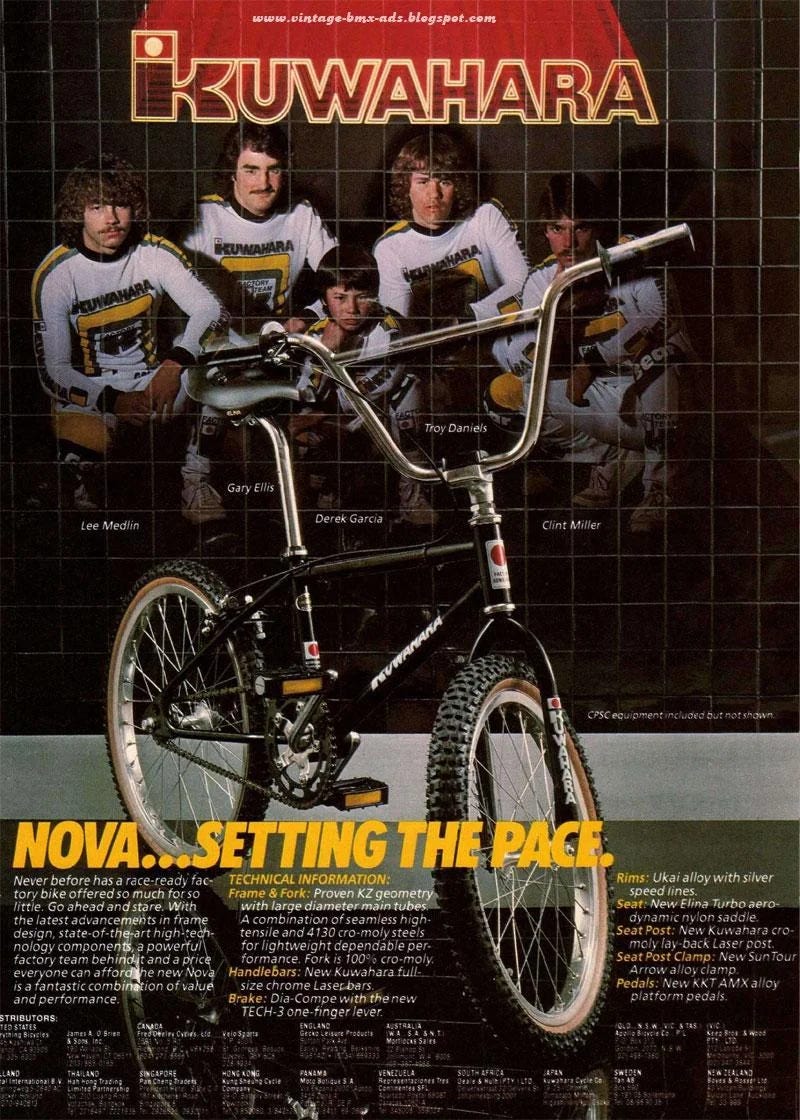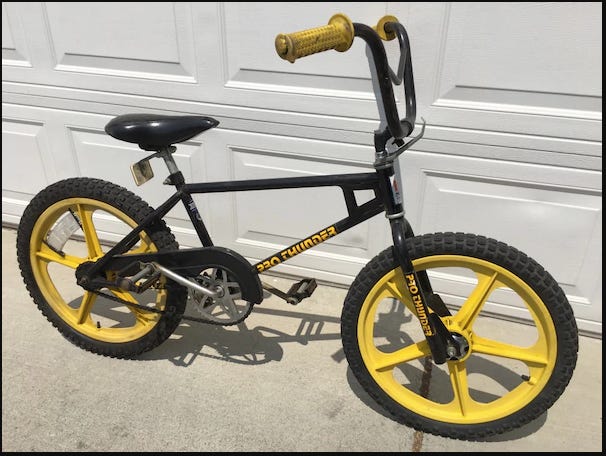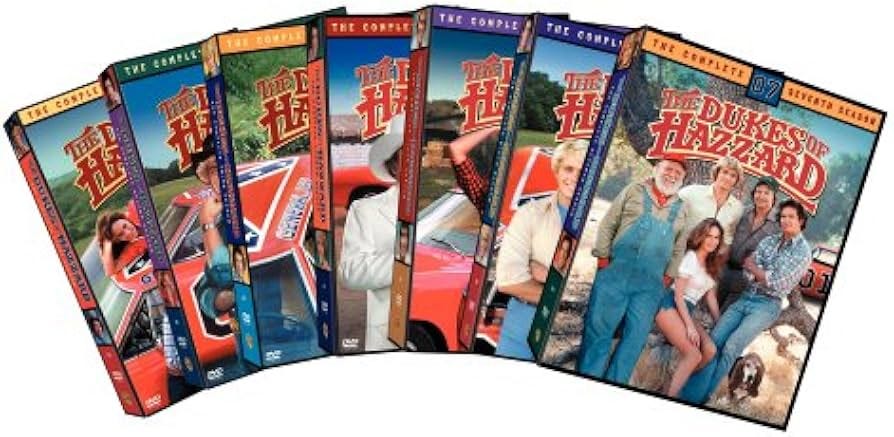Welcome to this edition of This Nostalgic Life where we’re talking about cool old bikes, physical media, great old music, and more. Let’s get started!
BMX: An Early 80’s Status Symbol
by Eric Vardeman
I don't know about you, but in my hometown in the early 80's BMX was a big deal. A huge deal, actually. On top of having an official, honest-to-goodness BMX racing track, there were off-road bike trails scattered all over town. They seemed to pop up everywhere. Some were just off-road trails that cut through fields and wooded areas while others had actual jumps and turns and hazards. Every kid my age had a BMX bike. The time frame I'm talking about is roughly 1981-83 so I was 11, 12, 13 years old. But BMX bikes weren't just used for transportation and recreation. They were also a status symbol. In a sort of weird hierarchy, the type of bike you had said a lot about your social standing, your riding ability and, much like gang territory, whether you were allowed to ride on certain bike trails or not.
There were three levels of BMX-ness. Level one was reserved for top-tier bikes like Hutch, Kuwahara, and Haro. This was rarified air. These bikes were expensive, and they were like Bigfoot: you heard stories about them but had never really seen one. There was one kid we knew of who had a bike in this category. He raced BMX - not only on our small-town track but regionally as well - and had a tricked-out Kuwahara. It was sleek and gorgeous and light as a feather. It had a number plate on the front with his earned competition number. He wouldn’t let ANYONE ride it. He was also able to perform all manner of tricks and stunts so when he was around we just stood there with our bikes for fear of looking stupid while riding in front of him.
The next level is where I LONGED to be but never reached. This level was reserved for mid-range bikes like Mongoose, Redline, and Diamond Back. I knew several guys who had bikes in this category. One kid in my neighborhood, Jesse, had a Redline Pro that he had saved enough money for and bought by working a paper route. God, it was a thing of beauty. Red, white, and chrome with red alloy rims (the picture below is a near replica). He had just graduated to this level of BMX and knew what it was like to be us, so he was cool enough to let us ride it from time to time. That is until one of us wrecked it while trying to jump off a brick retaining wall and scratched the body. Man, he was hot about that.
Then there were the rest of us. Kids that didn’t have a lot of money, who rode bikes from K-Mart, Walmart, and OTASCO. Schwinn, Huffy, Murray. They were heavy and clunky and not nearly as sexy as the bikes in the top two categories. I rode a Huffy Pro Thunder. It was plain and heavy as hell (mostly due to the enormous yellow mags) which made it nearly impossible to do anything on outside of ride. Not that I didn’t try, though. I can’t tell you how many times my bike was completely disassembled so it could be spray-painted (if I remember correctly, my bike was four different colors in its short lifetime). I also tried adding cooler accessories to it in hopes of making it seem like a nicer bike, but it was pretty much like putting lipstick on a pig. A spray-painted pig.
The one glaring difference in our low-end bikes and the bikes in the other categories was that our bikes had coaster brakes while the nice bikes were freewheel. What the heck does that mean? A bike with coaster brakes meant all you had to do to slow down (or “brake”) was pedal backward. Freewheel bikes, however, allowed you to pedal backward “freely” without slowing or stopping, and achieve that soothing, ASMR “clicking” sound as you did so. Freewheel bikes had a hand brake for the rear wheel that allowed you to slow or stop. So desperate were we to have freewheel bikes that we actually figured out how to convert our coaster brake rear wheels to freewheels. Who am I kidding? We didn’t so much figure it out as we accidentally stumbled onto the modification while experimenting with the idea. The only problem was that until we could install a hand brake, the bike didn’t have any brakes at all! An issue that brought several of us perilously close to death’s door on multiple occasions.
All this interest in BMX only lasted a couple of years but man what a couple of years it was. Full of painting and modifying, selling and trading, wrecking and repairing, accomplishments and injuries. I have scars on both my shins and one of my elbows to this day because of BMX incidents gone awry. For many of us, those bikes fell by the wayside when we hit junior high school. At that point, some kids aged out of BMX and into motorcycles (not me). Some of the guys that road BMX moved on to skateboarding (again, not me). Somehow, I ended up with a Schwinn ten-speed for a couple of years before abandoning bikes altogether.
Thoughts on Physical Media
by Mick Lee
Physical media is becoming harder to find in a world that embraces steaming more and more every day. It’s a frightening trend that I want to see reverse course. Let me say that I’m a proponent of owning physical media in all forms whether it be movies, music, video games, books, comic books, or whatever other forms of entertainment you enjoy. But for this post in particular, I’m only focusing on movies.
Last week my oldest daughter and I made a quick trip to our local Walmart to seek out a copy of the original Halloween movie from 1978. For some reason, I couldn’t find my copy and we wanted to watch it on Halloween night. At first, I thought it would be an easily solved problem in these glory days of streaming, but I was wrong. It was not available on any streaming service that we subscribe to, and that’s a lot. But no big deal, we’d just run out and pick up a physical copy of the DVD or Blu-Ray release. We had no luck in finding a copy to purchase, so we had to pick another movie from my collection to watch for Halloween.
The fact that I can’t find my DVD copy of the classic film is bad enough, but even scarier is the lack of physical movies available to purchase at retail locations these days. Our local Walmart had one small display of new-release movies…about 5 titles in all, and one small section of “horror” movies for the season. The horror section looked like it originally featured roughly 15 titles or so, but half of them were sold out this close to Halloween.
I certainly remember the days when Walmart had an entire aisle dedicated to DVDs, as well as a big bin somewhere else in the store filled to the brim with cheap $5 movies. But as streaming has become much more popular, fewer people are buying physical movies, thus Walmart and other retailers carry less of them. This is becoming really alarming as I feel like we are on the brink of seeing physical media disappear altogether due to the trends, especially with the recent news that Best Buy and Target will no longer be selling DVDs and/or Blu-Ray discs going forward. There is also the news from earlier this year that Redbox filed bankruptcy, so you can’t rent physical media either.
I’ve been a collector of physical media for years. Before DVDs came along, I had a budding collection of movies on VHS. Luckily I wasn’t too far into collecting them when DVD came along and was able to pivot to collecting the new form of media. In the years since, I amassed a collection of almost a thousand DVDs. Everything from kid’s movies to cult classics. But I greatly slowed my collecting as streaming became more popular, and eventually stopped buying DVDs altogether. I was part of the problem.
People like me slowed their buying and collecting habits so much, that the retail giants of the world slowed down their ordering of products, so distributors slowed down their production. The world we are left with today is small bare shelves where our favorite movies used to sit on display, waiting for someone to claim them and give them a loving home.
A lot of you reading this may fail to see the problem. You may still be having the same thoughts that I did for a few years. Thoughts like, “There are so many movies to choose from on streaming, why do I need to buy any?” or, “My favorite movies will always be available to stream.” Unfortunately, this isn’t always the case. Hell, there were a lot of years when I felt certain that The Andy Griffith Show would always be on TBS, but I missed on that one too. No, the scary truth is that we never know when our favorite movies or shows will be pulled from streaming for what could be a variety of reasons. The only way to safeguard against that is by owning physical copies of your favorites.
Let me share a few personal examples with you to help illustrate the point I want to make here.
One of my favorite examples centers around an early ’90s movie that was a big-budget movie that should have been a blockbuster but just fell short…Dick Tracy. I’ve searched high and low across all streaming services for years with no luck, as I don’t believe it’s ever been offered on a streaming service for whatever reason. If I want to watch it, I have to buy a physical copy of it, which is easier said than done. Head over to Amazon and do a search for it and see what you turn up. Nothing. It’s a near-impossible movie to find for whatever reason.
Or how about The Dukes of Hazzard? Thank God I purchased the complete series on DVD years ago as in the years since, it has been pulled from TV and streaming due to the controversy over the confederate flag being featured on the roof of the car. Because of the association, the show has been unofficially “canceled” in recent years, and you won’t see the show unless you own physical copies of it. This is one of my favorite examples actually because it illustrates that at any time, a favorite of yours could be pulled for any number of reasons.
Another fun example is the multitude of ’70s and ’80s movies that we all used to love renting from video stores back in the ’80s and ’90s. You know the ones that could never quite make the cut as “A” movies, but we loved them anyway? I’m talking about movies like Vanishing Point, Fortress, Duel, Crazy Mary Dirty Larry, White Line Fever, and too many more to name. Sure, every now and then some of them pop up on a streaming service somewhere, but are gon again nearly as quickly. Without owning physical copies, you find yourself at the mercy of the streaming giants, and the holders of the rights to the films, as to what you can see, and when you can see it.
I say all of this as an attempt to convince as many folks as possible to consider picking up physical copies of movies from time to time. The more that gets back in the game, then the more likely it is that the medium will not die out completely. If the production of physical media stops completely, then we no longer have control over our entertainment. We’ll always be at the mercy of big business to give us what they want us to have. Which I believe is why streaming became so popular in the first place, wasn’t it? To take control of our viewing away from the cable companies and put it into our own hands again? Now, it’s the streaming giants that threaten to do the same, and owning physical media is the new solution all over again.
In 1984: Billy Ocean reaches the top spot this week with “Caribbean Queen”. The song was initially released as "European Queen" early in 1984 but saw no chart success. At the record company's suggestion, it was re-recorded for different parts of the world resulting in the versions "Caribbean Queen" and "African Queen". In the US, the song was released under the title "Caribbean Queen (No More Love on the Run)". Ten weeks later, here we are. Ocean has stated: "The song was released in Europe as 'European Queen' and nobody was interested in it. When we changed the name to 'Caribbean Queen' and released it in the U. S., it took off and started snowballing and they started playing it in Europe. I guess it had more appeal as 'Caribbean Queen' because Europe conjures up a vision of rain and snow and cold, but Caribbean sounds like sunshine and blue skies. It's much more exotic."
In 1990: Vanilla Ice and "Ice Ice Baby" knock Janet Jackson from the top spot this week. The song was first released as the B-side to Vanilla Ice's cover of "Play That Funky Music", but that single had zero initial success. DJ's started playing "Ice Ice Baby" instead and the song quickly blew up. "Ice Ice Baby" was the first hip-hop single to top the Billboard Hot 100 and it samples the bassline of the song "Under Pressure" by British rock band Queen and British singer David Bowie, who did not receive songwriting credit or royalties until after it had become a hit.
Playlist: This Week In 1984
Playlist: This Week In 1990
In every edition of This Nostalgic Life, we like to share a curated list of nostalgia-themed articles, stories, and posts that we’ve come across recently. It gives you a chance to discover great content and remember things from your past that you may have forgotten. With that in mind, here are some things we wanted to share with you this week. (All links will open in a new tab.)
The Invisible Generation (Nostalgia Nation)
The Best One-Hit Wonders of the ‘80s (Audio Ink Radio)
The History and Cultural Significance of Board Games (Games Radar)
10 Things ‘That ‘70s Show’ Got Wrong About the ‘70s (Movie Web)
This Month in YesterYear History - November (YesterYear Retro)
The Late Great Quincy Jones (A Shroud of Thoughts)
Thank you for joining us for another issue of This Nostalgic Life. Be sure to leave us a comment about anything in this issue that connected with you and we can discuss in the comments section. See you next week for another nostalgia-packed issue!















